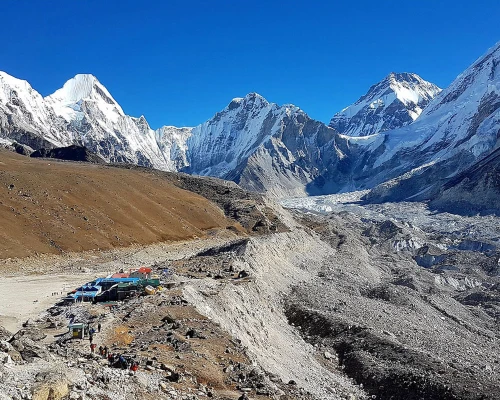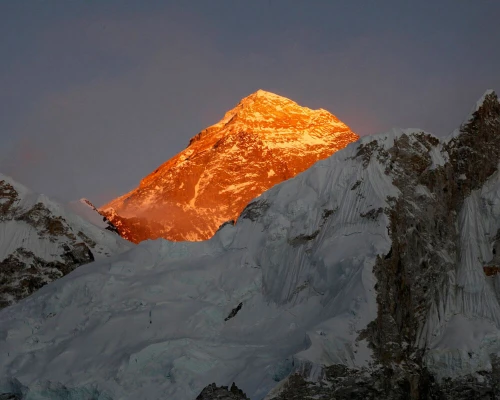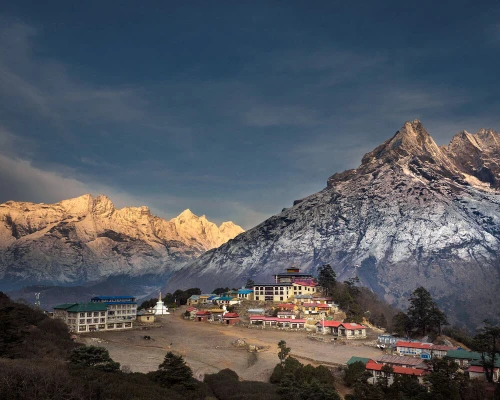Khumbu Trekking Photos: A Visual Journey Through the Everest Region
The Khumbu region, home to the world’s highest peak—Mount Everest (8,848.86 m)—is one of the most photogenic trekking destinations on Earth. Each step of the journey reveals jaw-dropping Himalayan panoramas, ancient Sherpa villages, fluttering prayer flags, and sparkling glaciers. Through Khumbu trekking photos, travelers can capture not only the grandeur of the mountains but also the cultural essence and spiritual heartbeat of Nepal’s Everest region.
1. The Gateway: Lukla – The Starting Point of Khumbu Trekking
Your photographic journey begins at Lukla (2,860 m), where a thrilling flight introduces you to the rugged Himalayan terrain. The Lukla airstrip, surrounded by towering hills and swirling clouds, is a favorite among photographers for its dramatic setting. From here, trekkers embark on the trail leading to Phakding and Namche Bazaar — two of the most scenic stops filled with lush pine forests and the roaring Dudh Koshi River.
📸 Photo Tip: Capture the take-off and landing of small planes at the Lukla airport and the vibrant market scenes filled with smiling Sherpa faces.
2. Namche Bazaar: The Heartbeat of the Khumbu
Nestled in a natural amphitheater, Namche Bazaar (3,440 m) is a lively mountain hub that perfectly blends tradition and modernity. This colorful town offers mesmerizing views of Kongde Ri, Thamserku, and the distant silhouette of Everest itself. Namche’s narrow streets, prayer wheels, monasteries, and friendly locals provide endless opportunities for photography.
📸 Photo Tip: Early morning photos from the Everest View Hotel capture the first golden rays hitting Ama Dablam and Everest—pure magic for your travel gallery.
3. Tengboche Monastery: A Spiritual Encounter
As trekkers ascend towards Tengboche (3,867 m), the iconic Tengboche Monastery emerges surrounded by snow-capped peaks. It’s one of the most sacred sites in the Khumbu region, where monks chant against a backdrop of Ama Dablam and Everest. The Mani Rimdu Festival celebrated here adds color, energy, and deep cultural value to your Khumbu trekking photos.
📸 Photo Tip: Frame the monastery’s golden rooftop with Ama Dablam glowing in the distance—an unforgettable Himalayan postcard.
4. Pangboche and Dingboche: Life in the High Himalayas
Moving higher, villages like Pangboche and Dingboche offer insight into Sherpa life at altitude. Stone houses, yak caravans, and terraced fields surrounded by dramatic peaks create picturesque compositions. As the air thins, the scenery turns stark yet strikingly beautiful.
📸 Photo Tip: Try sunrise shots over Dingboche with the sunlight illuminating Lhotse and Island Peak—ideal for landscape photography.
5. Lobuche to Gorakshep: The Final Ascent
The trail from Lobuche to Gorakshep (5,164 m) is filled with glaciers, icefalls, and memorial chortens dedicated to fallen climbers. It’s an emotional and awe-inspiring stretch for photographers. The icy landscape, constantly changing light, and sheer vastness make this section of the Khumbu one of the most photogenic places in Nepal.
📸 Photo Tip: Use a wide-angle lens to capture the Khumbu Glacier and the path leading toward Everest Base Camp—one of the most powerful visual stories you can tell.
6. Everest Base Camp: Standing Before the Giant
Reaching Everest Base Camp (5,364 m) is every trekker’s dream. Surrounded by immense peaks and the Khumbu Icefall, this spot symbolizes adventure and perseverance. Photos taken here embody the raw majesty of the Himalayas and the triumph of human spirit.
📸 Photo Tip: Snap shots with the “Everest Base Camp” rock marker, colorful prayer flags, and the massive Nuptse ridge looming behind. Sunrise and sunset lighting add dramatic tones to your photos.
7. Kala Patthar: The Ultimate Panorama
For the most breathtaking view of Everest, climb Kala Patthar (5,545 m). From here, you’ll witness the world’s highest peaks glowing gold at sunrise. The 360-degree panorama includes Everest, Nuptse, Lhotse, and Ama Dablam — a dream scene for every photographer.
📸 Photo Tip: Capture both wide panoramic shots and close-ups of the Everest summit with clouds swirling around its peak. A tripod helps achieve sharp images in low morning light.
8. Sherpa Culture and Everyday Moments
Khumbu trekking photos aren’t just about mountains—they’re about the people. The Sherpa community, with their deep-rooted traditions and warm hospitality, are the heart of the Everest region. From monks lighting butter lamps to children playing in stone-paved alleys, every image tells a story of resilience and spirituality.
📸 Photo Tip: Ask permission before photographing locals, and try candid shots of daily activities—yak herding, spinning prayer wheels, or preparing butter tea.
9. Flora and Fauna of the Khumbu
The Khumbu region lies within the Sagarmatha National Park, home to unique Himalayan flora and fauna. Rhododendron forests, juniper trees, and occasional sightings of Himalayan monals (Nepal’s national bird) add color and variety to your trekking photos.
📸 Photo Tip: Early mornings offer the best natural light for photographing wildlife and the play of mist through rhododendron forests.
10. Best Time for Khumbu Trekking Photography
The ideal seasons for photography in the Khumbu are spring (March–May) and autumn (September–November). During these months, skies are crystal clear, visibility is excellent, and mountain peaks shine brightly against blue skies. Spring also brings blooming rhododendrons, while autumn offers crisp air and golden light.
11. Essential Photography Tips for Khumbu Treks
Carry Extra Batteries: Cold temperatures drain power quickly.
Protect Your Gear: Use waterproof bags and lens cloths to avoid dust and moisture.
Use Polarizing Filters: To enhance contrast and bring out the deep blue of Himalayan skies.
Go Light: Trekking at high altitude is tough—balance gear weight carefully.
Respect Culture: Always ask before taking close-up portraits of monks or locals.
12. Why Choose Holiday Tours Nepal for Your Khumbu Trekking Adventure
At Holiday Tours Nepal, we specialize in guided treks through the Khumbu and Everest regions, ensuring safety, comfort, and unforgettable experiences. Our local guides know the best photo spots, lighting conditions, and scenic viewpoints for both professional and hobby photographers. Whether you’re aiming for Everest Base Camp Trek, Gokyo Lakes Trek, or Three Passes Trek, we make sure your photographic journey is as rewarding as the trek itself.
Conclusion
Khumbu trekking photos are more than just images—they are stories of courage, beauty, and discovery. Each frame captures a piece of the Himalayas that words can barely describe. So, pack your camera, lace up your boots, and embark on a journey that will fill your heart—and your memory card—with wonders that last a lifetime.
📅 Plan Your Khumbu Trekking Adventure Today!
Join Holiday Tours Nepal for an unforgettable journey through the Everest region.
👉 Contact us for customized Khumbu trekking packages and photography tours in 2025.





